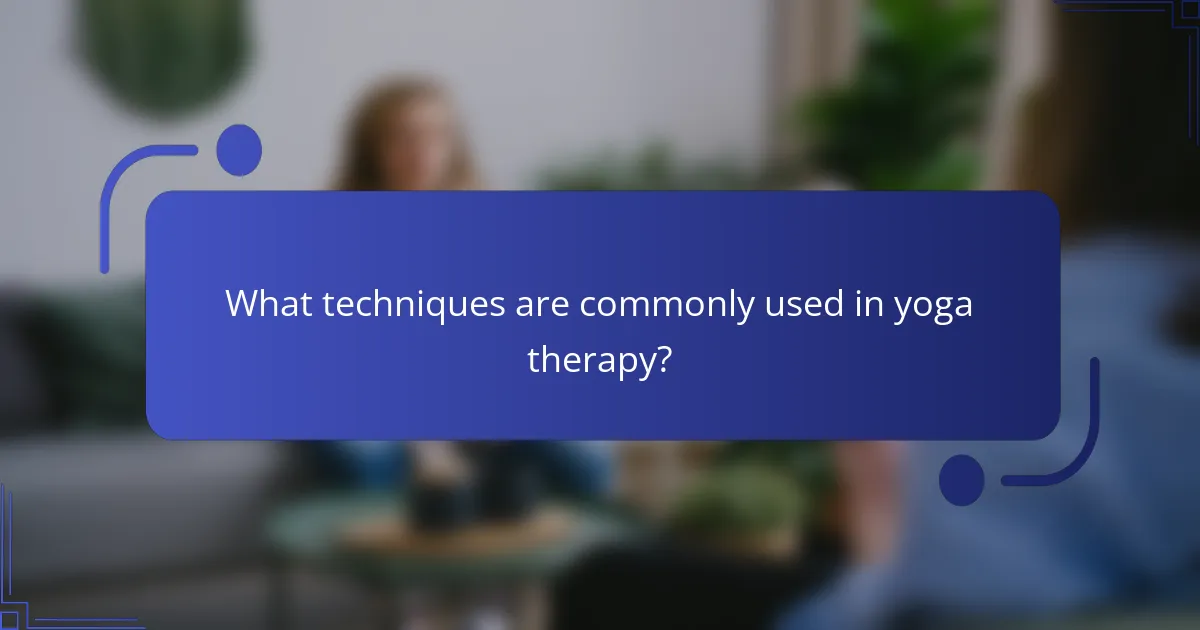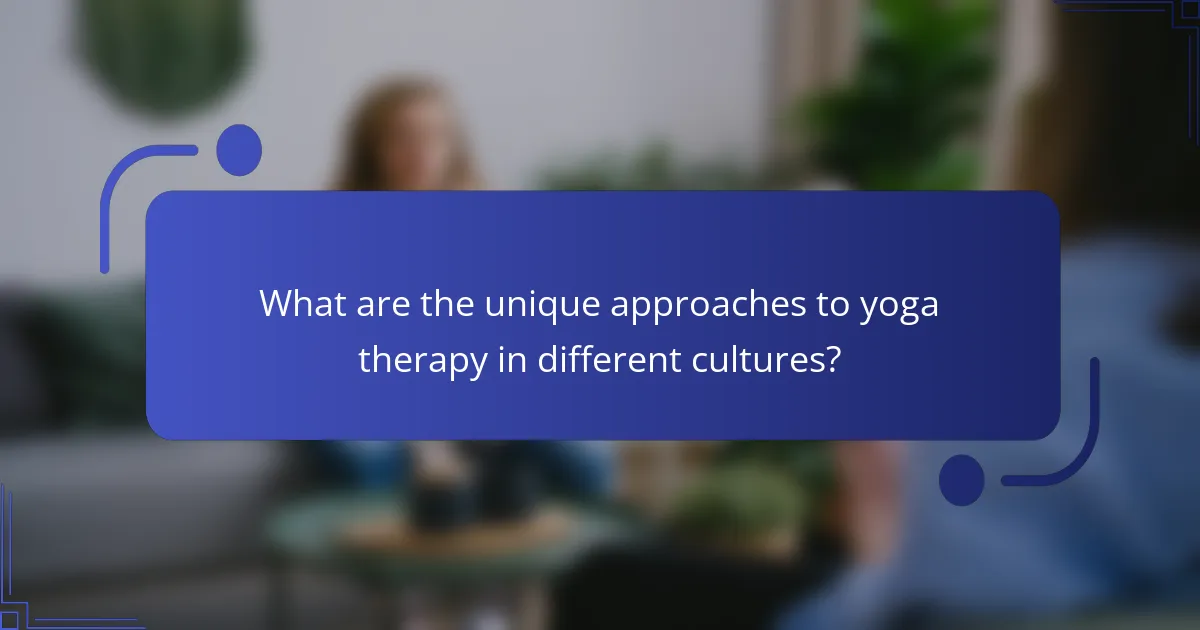Yoga therapy provides healing benefits like stress reduction and improved mental clarity. It employs techniques such as asanas, pranayama, and meditation for holistic well-being. Support networks enhance motivation and professional growth, while diverse cultural approaches enrich its practice. This article explores these aspects to highlight yoga therapy’s effectiveness and adaptability.

What are the healing benefits of yoga therapy?
Yoga therapy offers numerous healing benefits, including stress reduction, improved flexibility, and enhanced mental clarity. It promotes physical and emotional well-being through tailored techniques. Research indicates that consistent practice can alleviate symptoms of anxiety and depression, supporting overall mental health. Additionally, yoga therapy fosters community through support networks, enhancing motivation and accountability in the healing journey.
How does yoga therapy support mental health?
Yoga therapy significantly supports mental health by reducing stress, anxiety, and depression. It enhances emotional regulation and promotes mindfulness, which fosters resilience. Specific techniques, such as breathwork and meditation, improve mood and cognitive function. Studies indicate that regular practice can lead to lasting psychological benefits, making yoga therapy a valuable tool for mental well-being.
Which physical ailments can yoga therapy alleviate?
Yoga therapy can alleviate various physical ailments, including chronic pain, stress, anxiety, and digestive issues. It promotes relaxation and enhances overall well-being. Research indicates that yoga therapy may reduce symptoms of arthritis and improve mobility. Additionally, it supports recovery from injuries and aids in managing conditions like hypertension.
What role does mindfulness play in yoga therapy?
Mindfulness is central to yoga therapy, enhancing emotional regulation and stress reduction. It cultivates awareness of the present moment, fostering a deeper connection between mind and body. This practice can improve mental clarity and promote relaxation, making it an effective tool for healing. Mindfulness techniques, such as breath awareness and meditation, are often integrated into yoga therapy sessions, allowing individuals to process emotions and develop coping strategies. As a result, practitioners experience improved overall well-being and resilience.

What techniques are commonly used in yoga therapy?
Yoga therapy commonly utilizes techniques such as asanas, pranayama, meditation, and guided imagery. These approaches address physical, emotional, and mental health, promoting holistic healing. Asanas improve flexibility and strength, while pranayama enhances breath control and relaxation. Meditation fosters mindfulness, and guided imagery aids in visualization for stress reduction. Together, these techniques create a supportive framework for overall well-being.
How does breathwork enhance yoga therapy effectiveness?
Breathwork significantly enhances the effectiveness of yoga therapy by promoting relaxation and mindfulness. It improves the connection between breath and movement, facilitating deeper emotional release and physical healing. Breathwork techniques, such as pranayama, optimize oxygen flow, reduce stress, and enhance focus during yoga sessions. This holistic approach supports mental clarity and emotional balance, making yoga therapy more impactful.
What specific postures are beneficial for therapeutic purposes?
Yoga therapy includes various postures that promote healing and well-being. Specific beneficial postures are Child’s Pose, Downward Dog, Cat-Cow, and Forward Bend. These postures enhance flexibility, reduce stress, and support overall physical health. Regular practice can improve mental clarity and emotional balance.
How can meditation be integrated into yoga therapy sessions?
Meditation can enhance yoga therapy by promoting relaxation and mindfulness. Integrating meditation techniques, such as focused breathing or visualization, can deepen the therapeutic experience. This combination addresses mental and emotional well-being, supporting stress reduction and emotional balance. Additionally, guided meditations can help clients connect with their bodies, enhancing the overall healing process.

What support networks exist for yoga therapy practitioners?
Support networks for yoga therapy practitioners include professional associations, online communities, mentorship programs, and local meetups. These networks provide resources, training opportunities, and peer support.
Professional associations like the International Association of Yoga Therapists offer certification and continuing education. Online platforms such as social media groups enable practitioners to share experiences and advice. Mentorship programs connect new therapists with experienced professionals for guidance. Local meetups foster community and collaboration among practitioners in the same area.
These support systems enhance the practice of yoga therapy, promoting professional growth and collaboration.
How can local communities enhance yoga therapy accessibility?
Local communities can enhance yoga therapy accessibility by fostering inclusive environments, providing affordable classes, and promoting awareness. Collaborating with local health organizations can facilitate access to trained instructors and resources. Additionally, creating support networks encourages participation and sharing of experiences. Community outreach programs can further engage diverse populations, ensuring that yoga therapy reaches those who may benefit most.
Which online platforms offer resources for yoga therapy?
Several online platforms offer valuable resources for yoga therapy. Notable options include Yoga Journal, which provides articles and tutorials, and the International Association of Yoga Therapists, offering a directory of certified therapists and educational materials. Additionally, platforms like Udemy and Coursera feature courses on yoga therapy techniques, enhancing knowledge and practice. Lastly, YouTube hosts numerous channels dedicated to yoga therapy practices, making it accessible for all levels.

What are the unique approaches to yoga therapy in different cultures?
Different cultures employ unique approaches to yoga therapy, emphasizing various healing benefits and techniques. For instance, Indian yoga therapy often integrates traditional Ayurvedic principles, focusing on balancing doshas to promote holistic well-being. In contrast, Western adaptations may prioritize physical rehabilitation and stress relief, utilizing evidence-based practices to support mental health.
Japanese yoga therapy frequently incorporates elements of Zen Buddhism, emphasizing mindfulness and breath control to enhance mental clarity. African practices may blend yoga with indigenous healing rituals, fostering community support networks that enhance emotional resilience.
Each cultural approach highlights distinct attributes, showcasing the adaptability of yoga therapy to meet diverse healing needs globally. These unique perspectives enrich the overall understanding and practice of yoga therapy.
How does yoga therapy differ in Eastern versus Western practices?
Yoga therapy in Eastern practices emphasizes holistic healing, focusing on the mind-body connection, while Western practices often prioritize physical alignment and therapeutic techniques. Eastern approaches integrate meditation and spiritual aspects, promoting emotional well-being. In contrast, Western methods may rely on scientific research, emphasizing evidence-based techniques. Both practices aim to enhance well-being but differ in their foundational philosophies and techniques.
What are the rare techniques used in specialized yoga therapy?
Rare techniques in specialized yoga therapy include Viniyoga, which tailors practices to individual needs, and Yoga Nidra, a guided meditation for deep relaxation. Other techniques are Somatic Yoga, focusing on body awareness, and Trauma-Informed Yoga, addressing past trauma. Each method enhances healing by incorporating unique approaches to physical and emotional wellness.

What best practices should be followed in yoga therapy?
Yoga therapy best practices include personalized assessments, regular practice, and integration of mindfulness. Establish clear goals to guide the therapy process. Use a variety of techniques, such as breathwork and meditation, to enhance healing. Foster a supportive community for ongoing encouragement and feedback.
How to choose the right yoga therapist for individual needs?
To choose the right yoga therapist, prioritize their qualifications, experience, and approach to therapy. Consider their specialization in addressing specific needs, such as stress relief or chronic pain management. Look for therapists with a strong background in anatomy and physiology. Verify their certifications and training in recognized yoga therapy programs. Seek recommendations and read reviews to assess their effectiveness and client satisfaction. Finally, schedule an initial consultation to gauge compatibility and communication style.
What common mistakes should be avoided in yoga therapy?
Common mistakes to avoid in yoga therapy include neglecting individual needs, skipping proper training, and overlooking contraindications. Practitioners should personalize sessions based on client conditions and goals. Inadequate training can lead to ineffective techniques, while ignoring health issues may cause harm. Regular assessments and adjustments are essential for safe practice.


